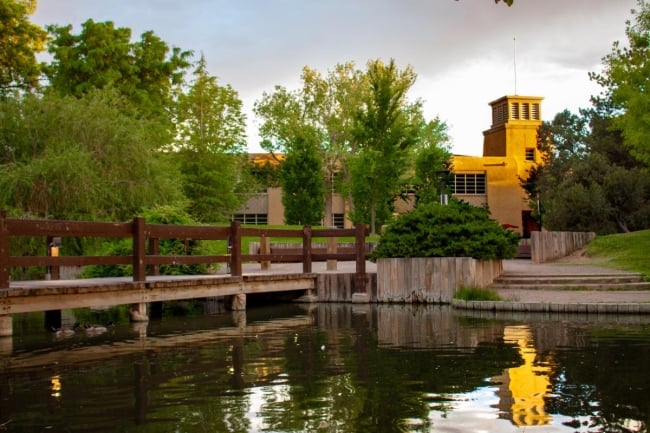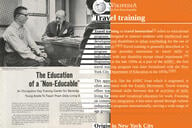You have /5 articles left.
Sign up for a free account or log in.

The University of New Mexico campus in Albuquerque
Getty Images/Raisa Nastukova
The Opportunity Scholarship attracted national attention when it was first touted by New Mexico governor Michelle Lujan Grisham, a Democrat, as an "unprecedented" opportunity for students in a state with an 18.2 percent poverty rate as of 2019 (nearly eight percentage points higher than the national poverty rate).
Lujan Grisham's proposal would have covered tuition and fee costs for recent high school graduates and returning adults, as well as undocumented students, at all public institutions of higher education in the state. It was proposed as a last-dollar scholarship, meaning it would cover the remaining costs after all other aid, like federal Pell Grants, were applied.
But the proposal never made it past committee in the state Legislature. It was eventually added to legislation for the state's budget, where it was pared down in some respects and beefed up in others. Among other things, it ended up being just for community colleges.
The scholarship was criticized at the time for being last dollar. Some higher education experts argue that first-dollar programs, which cover tuition and fees before other aid is applied, are better, because students can then use other aid to cover expenses like books and food. Some also criticized the proposal for relying heavily on revenue from the oil and gas industry.
The scholarship now only covers two-year programs at public institutions in the state. But it's now a so-called middle-dollar scholarship. Students must first use other state aid and scholarships to cover tuition and fees, and then the Opportunity Scholarship will cover the remainder. Federal financial aid will be applied to costs after the Opportunity Scholarship -- so students could use their Pell Grants for nontuition expenses like books and housing.
This fall, 4,231 students received the scholarship, costing the state nearly $3 million.
These changes seem to have assuaged criticisms that the scholarship faced when it was first announced.
"While the program doesn’t take on a full first-dollar approach, it’s good to see that federal aid is applied after the fact so that students have the opportunity to apply the funds to much of the true cost of college, like living situations, childcare, transportation and other nontuition needs," said Tamara Hiler, director of education at Third Way, a center-left think tank in Washington, D.C.
A hearing brief from the Legislative Finance Committee outlines some of the critiques of the original proposal. It states the requested funds for the original program may have been too low. The committee's analysis showed it could cost as much as $49 million -- 40 percent higher than the Higher Education Department's funding request.
It also pointed to research that shows tuition and fee costs are often not the major obstacles for students, especially in states like New Mexico, which has some of the lowest tuition costs in the nation. Rather, expenses like transportation, housing and food are major barriers for low- and middle-income students. The brief states that last-dollar programs can be regressive for that reason.
The brief recommended the state use existing tools to improve college access, including increasing investments in first-dollar student incentive grants that target students based on financial need, enhancing the state's first-dollar lottery scholarship and providing resources for the Higher Education Department to increase completion rates of the Free Application for Federal Student Aid.
The choice to scale the scholarship back to just cover two-year programs was to save costs, according to William Soules, a state senator and chair of the Senate Education Committee.
Students who complete two-year programs also are more likely to stay in New Mexico and take jobs that help rebuild the state, such as nursing, Soules said.
"People felt we should go slow and see how this works, and possibly expand in future," he said.
Andrés Romero, a state representative and chairman of the House Education Committee, feels the proposal should have covered four-year programs.
"I think we should be aiming to cover the costs for as many students as possible in New Mexico," he said. He hopes the program can be built up over time to include four-year programs.
It's unclear what will happen to the program in the future. It originally received $17 million in January, but that was cut to $10 million during a special legislative session due to the pandemic. About $5 million of that is nonrecurring. The Higher Education Department will have to request funds in each budget to support the program going forward.
One of the key benefits of the original proposal was the inclusion of four-year colleges, said Tiffany Jones, director of higher education policy at the Education Trust, an advocacy organization for equity in education in D.C.
"It’s important that free college transforms our current system where students aren't making decisions based on what they can afford," she said.
If policy makers focus on two-year programs, they also need to find ways to improve transfer for students, said Wil Del Pilar, vice president of higher education policy and practice at Ed Trust.
Del Pilar doesn't think there's evidence that providing assistance for four-year programs would be regressive. Only two institutions in New Mexico -- one two-year and one four-year college -- have Pell Grant enrollment rates below 15 percent. Some four-year institutions have Pell Grant enrollment rates of more than 40 percent, he said.
"There are very needy students walking around four-year institutions in New Mexico," he said.
But the middle-dollar approach is interesting, Del Pilar said.
"It's definitely a better approach than last-dollar programs," he said. "We should commend them for that."
The state could go further by simplifying its four scholarship programs, or targeting lower-income students by placing income caps on the aid. This could free up more money to provide emergency aid or invest in greater student support services.
"For these types of programs to have more use and applicability for students, we need to really think about who we want to serve," he said.
The changes in messaging from when the proposal made headlines to when it went into action are concerning, though, Jones said.
"There is already kind of a broken relationship between higher education and the public. This is the last thing folks need," she said. "The implications here can go further than a student not being able to enroll. It can further break that bond between higher education and its duty to serve the public."




